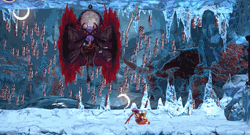 I distinctly remember the balmy, summer-ish eve that I decided to pull the trigger on contributing to the Bloodstained Kickstarter. The actual date has been lost to time, but I recall I had blown some wad of cash on another random item that week, and I was, at that very moment, having a meal out with some friends. Or, to be more accurate, I was waiting for them to arrive at the eatery, killing time outside (thanks to some form of brain damage, I am continually early for every social event), and, despite the fact that I felt I was somehow financially in the red that week (same brain damage: I could have a million dollars in my bank account and still think that spending twenty bucks on extraneous buffalo wings will bankrupt me), I did it. I decided to contribute a chunk of cash to Koji Igarashi’s latest project. Sure, the final product might turn out terrible without whatever secret sauce Konami was presumably bringing to the table, but I was willing to gamble on a director that had paid off in the past. Now it was just a matter of going into that Denny’s, enjoying my meal with friends, and waiting.
I distinctly remember the balmy, summer-ish eve that I decided to pull the trigger on contributing to the Bloodstained Kickstarter. The actual date has been lost to time, but I recall I had blown some wad of cash on another random item that week, and I was, at that very moment, having a meal out with some friends. Or, to be more accurate, I was waiting for them to arrive at the eatery, killing time outside (thanks to some form of brain damage, I am continually early for every social event), and, despite the fact that I felt I was somehow financially in the red that week (same brain damage: I could have a million dollars in my bank account and still think that spending twenty bucks on extraneous buffalo wings will bankrupt me), I did it. I decided to contribute a chunk of cash to Koji Igarashi’s latest project. Sure, the final product might turn out terrible without whatever secret sauce Konami was presumably bringing to the table, but I was willing to gamble on a director that had paid off in the past. Now it was just a matter of going into that Denny’s, enjoying my meal with friends, and waiting.
That was 2015.
It is now 2024. As of this June, the final “piece” of Bloodstained has been released. That guy standing in front of a Denny’s plugging his credit card information into Kickstarter is a stranger from a lifetime ago.
But Bloodstained: Ritual of the Night is still pretty damn familiar.
Said it before, I’ll say it again: I contributed to the Bloodstained Kickstarter entirely on the faith that we would see another Castlevania game. This could have gone poorly! History has proven that directors/developers may make “the same game” they made years earlier, or they might deviate wildly and produce something much more akin to their more recent releases. Look, if you don’t like clicking on links, I’m talking about Mighty No. 9, and that was a game where everyone wanted Mega Man 11 (not that one), and we got Mega Man ZX: Advent: The Next Generation. I will defend that game to my dying day (weirdly genuine statement: I like pressing the dash button every two seconds), but I completely understand why some people thought Might No. 9 was a Mighty Big No. Conversely, no one has to defend Bloodstained: Ritual of the Night! It is 100% a Castlevania title with the serial numbers filed off (Gremory is apparently Death’s first name). If you contributed to Bloodstained because you wanted another Symphony of the Night, you damn well got it, right down to a very familiar librarian.
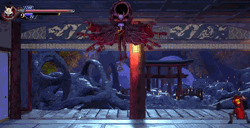 But noting the parallels to the Castlevania franchise may be reductive of Bloodstained: Ritual of the Night. B: RotN is an amazing game all on its own, and (according to backer rewards) Director Igarashi’s largest castle (and thus, game) in history. That’s something to say about the man who partially (and occasionally literally) defined the genre! And while you have plenty of unique monsters creeping about (those Killer Barbers are still hair-raising after five years), there are also quite a few blob critters that behave suspiciously like established skeletons. The emphasis on meals and commerce is a recognizable echo of IGAvania titles, and some of the more dramatic bosses may as well come with a “you’re going to recognize this pattern” warning. In short, there is more Castlevania here than a mere echo of a premise.
But noting the parallels to the Castlevania franchise may be reductive of Bloodstained: Ritual of the Night. B: RotN is an amazing game all on its own, and (according to backer rewards) Director Igarashi’s largest castle (and thus, game) in history. That’s something to say about the man who partially (and occasionally literally) defined the genre! And while you have plenty of unique monsters creeping about (those Killer Barbers are still hair-raising after five years), there are also quite a few blob critters that behave suspiciously like established skeletons. The emphasis on meals and commerce is a recognizable echo of IGAvania titles, and some of the more dramatic bosses may as well come with a “you’re going to recognize this pattern” warning. In short, there is more Castlevania here than a mere echo of a premise.
And then there are the spin-off titles. Those guys make the parallel more than a little obvious.
Bloodstained: Ritual of the Night was technically the game you backed as part of that Kickstarter in 2015. It was released four years later, in 2019. A year before that, we got the Kickstarter reward of “a retro-style prequel minigame”, Bloodstained: Curse of the Moon. While it did mutate from its original intention of a “prequel” to more of a “side story/alternate dimension/moon-hate fanfiction” it did not stray from the retro concept. This game looked like a an 8-bit title (albeit one knowingly designed for an expanded palette), and, more importantly, it played a hell of a lot like the 8-bit luminary Castlevania 3. It was much more than Castlevania 3, though, with branching stages, stories, upgrades, gameplay, and some extremely carefully considered platforming, And it was enough of a success that it led to its own sequel, Bloodstained: Curse of the Moon 2, which was released a year after Bloodstained: Ritual of the Night. Part of the inspiration for this one seemed to come from a need to confirm that the previous Curse of the Moon was a side story, as CotM2 ends with the mundane hero flying to space and slicing celestial bodies in twain. That… doesn’t quite work with the generally horror-gothic world of the “real” series. But other than that, what we wound up with was a combination of Castlevania 3 and a Mega Man game (not super surprising, given the involvement of Inti Creates and their involvement with the Mega Man franchise). Nobody could complain about such a fusion any more than they would disparage a Welsh Corgi riding a robot suit. A fun time was had by all, and this was easily the most original of any of the Bloodstained spin-off titles.
But originality is overrated.
 Bloodstained: Ritual of the Night Classic Mode was released in January of 2021. It is an unholy amalgamation of multiple classic 2-D Castlevania titles (that would be the ones that were not directed by Igarashi). Miriam is once again stalking through Gebel’s castle to defeat Gebel or any nefarious blondes that may be about, but her subweapons are now limited to exact matches for Simon’s arsenal from Castlevania. General level/castle layouts appear to be modified from Castlevania (and a few from Castlevania 3), and bosses are unique in name, but not in direct parallels to Castlevania threats (Frankensteins and Wolfmen are basically the same thing, right?). Even the game’s ending is a direct homage to Super Castlevania IV (no link? I never wrote an article on that one? Weird). And while everyone wants to look at this castle and call it wall-to-wall Castlevania 1, Miriam’s movements take a page from the Smash Bros. manual and adopt Richter’s more dynamic movements. If Simon Belmont performed one of his descendant’s backflips, his knees would shatter instantly. Miriam has no such issues, though, so she can leap like a Wachowski protagonist while bat dodging. B:RotN: Classic Mode does exactly what an homage should do: it improves on the original, and gives you a deeper understanding of what was great about a game from 1986. (And, gee, why is the hardest difficulty mode called “1986”?)
Bloodstained: Ritual of the Night Classic Mode was released in January of 2021. It is an unholy amalgamation of multiple classic 2-D Castlevania titles (that would be the ones that were not directed by Igarashi). Miriam is once again stalking through Gebel’s castle to defeat Gebel or any nefarious blondes that may be about, but her subweapons are now limited to exact matches for Simon’s arsenal from Castlevania. General level/castle layouts appear to be modified from Castlevania (and a few from Castlevania 3), and bosses are unique in name, but not in direct parallels to Castlevania threats (Frankensteins and Wolfmen are basically the same thing, right?). Even the game’s ending is a direct homage to Super Castlevania IV (no link? I never wrote an article on that one? Weird). And while everyone wants to look at this castle and call it wall-to-wall Castlevania 1, Miriam’s movements take a page from the Smash Bros. manual and adopt Richter’s more dynamic movements. If Simon Belmont performed one of his descendant’s backflips, his knees would shatter instantly. Miriam has no such issues, though, so she can leap like a Wachowski protagonist while bat dodging. B:RotN: Classic Mode does exactly what an homage should do: it improves on the original, and gives you a deeper understanding of what was great about a game from 1986. (And, gee, why is the hardest difficulty mode called “1986”?)
But, while it praised the action titles of Castlevania 1, 3, 4, and Rondo of Blood (which is… what? Castlevania 6?), Castlevania 2 didn’t see much love in Classic Mode. And Castlevania 2 was the one that arguably started the ‘vania part of the metroidvania genre that we love so well! Where was justice for Simon’s Quest?
Now, in 2024, we finally see Simon get his due. Bloodstained: Ritual of the Night Classic II: Dominique’s Curse is definitely the Castlevania 2 to Classic Mode’s Castlevania. Dominique is our protagonist this time, and she starts with a proper Simon Belmont moveset that showcases all the agility of a sentient beanbag. She can jump! She can whip! She can walk! That’s about it! And Dom must (slowly) trudge through towns, countryside, and a handful of mansions to find a cure for her curse and hopefully escape and/or conquer a blighted land. There is a recognizable day/night cycle, some extremely familiar stage layouts, and even mansion-based merchants that are reminiscent of stake-sellers of a game past. This is a loving homage to Castlevania 2.
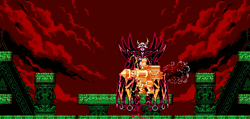 And, now five years after the release of Bloodstained: Ritual of the Night and almost a complete nine years after the Kickstarter that kickstarted (hey) it all, do we want anything different? Said it at the top: Bloodstained was funded by people that wanted more Castlevania. Now, at the official end of Der Ring des Bloodstained, nearly a decade of a game going from conception to a franchise unto itself, we have one giant IGAvania, multiple experimental ways to play through that beast, and four individual games that are all unique variations on Castlevania titles.
And, now five years after the release of Bloodstained: Ritual of the Night and almost a complete nine years after the Kickstarter that kickstarted (hey) it all, do we want anything different? Said it at the top: Bloodstained was funded by people that wanted more Castlevania. Now, at the official end of Der Ring des Bloodstained, nearly a decade of a game going from conception to a franchise unto itself, we have one giant IGAvania, multiple experimental ways to play through that beast, and four individual games that are all unique variations on Castlevania titles.
Maybe we want some actual Castlevania titles? How many of those did we see during Bloodstained’s time? Well, we got the abysmal Castlevania: Lords of Shadow – Mirror of Fate mere months before the Kickstarter officially started (but we will count it for being within the same year), and Castlevania: Lords of Shadow 2, a 3-D action game closer to God of War, the following February. And that’s it! We’ve got a successful Netflix show, a few compilations of the golden oldies, and pachinko machines, but no actual Castlevania games in all that time. Meanwhile, Bloodstained’s five different ‘vania-like games gave us an average of one Castlevania game every other year. That’s just like the NES days! Good ol’ reliable Castlevania is here, just in Bloodstained form.
Looking back to 2015, my own life has gone through so many changes and permutations in nearly a decade, I am not certain I would even understand the nerd forking cash over to Kickstarter outside a Denny’s. But whether I am 40 or 30 or 8, I understand Castlevania. And the people behind Bloodstained and its various attendant games understand Castlevania, too. I can have as much fun as I had with Classic Mode II now as I had with Simon’s Quest back when I was scribbling a neighbor’s all items password on an errant piece of “drawing paper”. I can enjoy replaying Bloodstained proper as Shantae as I did when I found the Axe Armor code for Symphony of the Night. Times may change, people may change, but some experiences are timeless.
I know a classic when I see one.
FGC #666 Bloodstained: Ritual of the Night Classic II: Dominique’s Curse
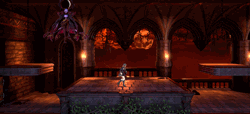 System: Let’s go ahead and assume this mode is available anywhere Bloodstained is sold. Playstation 4, Xbox One, Nintendo Switch, and PC/Mac all make sense here. But is it still getting updates on the Stadia?
System: Let’s go ahead and assume this mode is available anywhere Bloodstained is sold. Playstation 4, Xbox One, Nintendo Switch, and PC/Mac all make sense here. But is it still getting updates on the Stadia?- Number of players: Bloodstained proper did eventually get a multiplayer mode, and Circle of the Moon 2 also had simultaneous 2-player action, but we are talking about Classic II today, and that’s a solitary quest.
- Let’s not talk about Classic II Today: Given this is my theoretical final word on Bloodstained: Ritual of the Night, I feel it is pertinent to address the various bits of Bloodstained that have been released since the initial launch. Here’s what I got: I don’t like randomizers, I don’t like rogue-likes, I don’t like Child of Light, I don’t like Journey, I don’t like competitive multiplayer. I would like playing as the bosses if their mode didn’t feel so weirdly constrained. I do like playing as Zangetsu and Bloodless through a whole castle. I very much enjoy that the DLC/cosmetic costumes have upgrades of their own, so they do not fall into the typical DLC pratfall of either being too powerful or limited to the start of the game. I like playing Bloodstained in general enough to give anything I don’t like a chance.
- You really don’t like Journey? I think it is a singular experience that is cheapened every time it appears outside of the context of its original game.
- You really don’t like Child of Light? Nope.
- What about the Kingdom Two Crowns content? I refuse to understand a single word of that question.
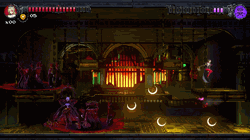 Let’s get back to Classic II: Was anyone else confused by the day/night cycle hijinks? There are hunters that only appear at night, but only one of them will ever be directly in your way, and the rest must be found in areas that literally do not exist during the day. Mansions are apparently not impacted by the phases of the moon, except the one that absolutely is different in practically every way. And fighting through a town at night is fun an’ all, but it sure does feel like a waste of time (or an Eye of Horus) when you are trying to do anything. I cannot believe I long for the days when a horrible night to have a curse just meant an extra durable skeleton…
Let’s get back to Classic II: Was anyone else confused by the day/night cycle hijinks? There are hunters that only appear at night, but only one of them will ever be directly in your way, and the rest must be found in areas that literally do not exist during the day. Mansions are apparently not impacted by the phases of the moon, except the one that absolutely is different in practically every way. And fighting through a town at night is fun an’ all, but it sure does feel like a waste of time (or an Eye of Horus) when you are trying to do anything. I cannot believe I long for the days when a horrible night to have a curse just meant an extra durable skeleton…- And while we’re complaining: All of the upgrades you get across the game are amazing! Nothing like underwater mobility or dimensionally shifting. Except! That first “dash attack” you earn from the (presumably) first mansion is super useless. It has a purpose! It makes combat a little easier, I guess. But I was expecting a slight air dash or “slide” that could access new areas, and it is sadly just kinda there. At least give me a rib-shield or something.
- Favorite Mansion: The clocktower area is a masterclass in limited platforming. In fact, that area was so carefully designed and interesting to traverse that I was almost disappointed when I acquired later, better movement options. A double jump or being able to infinitely generate floating platforms kind of neuters future challenges. Just ask Mega Man!
- See the World: This is the first Bloodstained game/spinoff/whatever that spends the majority of its time outside, and not stuck in a musty old castle. Get out there and explore the countryside! I mean, it’s a demonic countryside in a horrible Limbo… but still!
- Did you know? Focalor is showcased in 3-D “modern” Bloodstained graphics for the first time in Classic Mode II, appearing previously in 8-bit form in Curse of the Moon. This turtle-dude boss monster was originally intended to be in Bloodstained: Ritual of the Night proper, and was to be the source of the “move underwater” shard (that was then passed off to random minions), but was cut late in production. Given he appears with a quartet of other established B:RotN bosses here, let’s just assume the canon explanation for his absence from Miriam’s quest was that he simply did not find Gebel’s castle moist enough.
 Wait, come to think of it: Bloodless did not appear in either of the Classic Mode games. Even Zangetsu got to be a doppelganger!
Wait, come to think of it: Bloodless did not appear in either of the Classic Mode games. Even Zangetsu got to be a doppelganger!- Would I play again: Whether this question is about the whole Bloodstained: Ritual of the Night package or just Classic II, the answer is still a resounding yes. I love me some Castlevania content, and cannot wait for the inevitable sequel (that maybe is also five whole games, too).
What’s next? Random ROB has chosen… Marvel Super Heroes! Let’s see what our favorite tentacle monster is up to! Please look forward to it!

[…] is already an article on the site about Bloodstained: Ritual of the Night Classic II: Dominique’s Curse. Though, in thinking about it, you could easily make the argument that that essay is more about […]